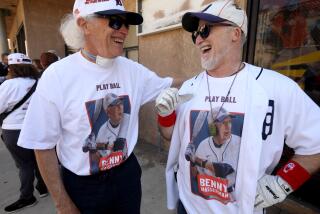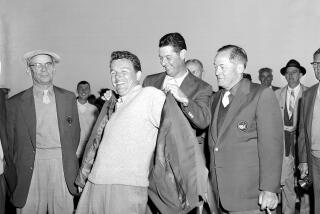Jack Kramer dies at 88; champion ushered in era of pro tennis
Tennis legend Jack Kramer, considered by many the most influential person in the game in the last 60 years, died late Saturday night at his home in Los Angeles. He was 88.
He had been diagnosed in mid-July with soft tissue sarcoma, a cancer of the connective tissues, said Bob Kramer, one of his sons.
Kramer won the prestigious Wimbledon title in 1947 and won U.S. Championships, the forerunner of today’s U.S. Open, in ’46 and ’47. He also won seven other Grand Slam titles in doubles. His Wimbledon victory was a startling 45-minute breeze past Tom Brown, 6-1, 6-3, 6-2.
It was his 1947 U.S. title that led to changes in a sport that had been, for the most part, hypocritical. Players competed for trophies and nothing else. At least that’s what they said.
“The amateur game was phony,” Kramer said years later. “Kids were all getting money under the table.”
So when he took the court for the ’47 U.S. final, Kramer had made a decision that would affect the sport forever, a decision that prompted Hall of Fame tennis journalist Bud Collins to say Sunday, “From a competitor to an administrator to a broadcaster, Jack Kramer was the most important figure in the history of the game.”
Before that ’47 U.S. final, Kramer had decided to turn pro.
“It was simple,” he said. “I needed the money.”
A deal was in hand with a tennis promoter and needed only a top performance from Kramer in the tournament. But that looked shaky when he lost the first two sets of a best-of-five final to Frankie Parker. He recalled that he looked into the stands to find the man with whom he had cut the deal, but all he could see was his bald head, because the man was sitting with his face in his hands.
Either inspired or petrified, Kramer won the next three sets, losing only four games on the way to the title and setting the stage for tennis’ pro era to take off. Two months later, his pro tour, a night-to-night barnstorming of cities across the world, attracted a crowd of 15,411 to Madison Square Garden -- in the middle of a blizzard.
Soon the success of the pro tours, Kramer’s the most prominent, put pressure on the tennis federations, whose tournaments were no longer offering fans all the best players. That pressure eventually led to the establishment of Open tennis in 1968, featuring prize money for all players.
Kramer, who had served in World War II as a Coast Guard officer on landing craft in the Pacific, suffered from an arthritic back and by 1954 was finished as a player. But the cause of other players remained a motivation for him, and by 1973 he had become executive director of the Assn. of Tennis Professionals, the predecessor of today’s ATP World Tour.
In ‘73, Niki Pilic refused to play on Yugoslavia’s Davis Cup team, and his suspension by the International Tennis Federation extended through the dates of Wimbledon that year. When Wimbledon honored that suspension and refused to let Pilic play there, Kramer led a player boycott, Wimbledon ended up with a less-than-quality field and Kramer had helped players gain even more control of their game.
“He was a huge figure in tennis,” said Rod Laver, who came along a generation later and said he benefited greatly from Kramer’s pioneering. “We all needed money and he helped a lot of players get some.”
Kramer’s antiestablishment stances occasionally cost him.
The year after he won the Wimbledon title, he went to watch his close friend Ted Schroeder of San Diego play there.
“The year before, a member of the royal family had handed me a trophy,” Kramer said a few years ago. “But this time, I was a pro. They wouldn’t even let me in the locker room.”
Collins, who did many broadcasts with Kramer and said he was excellent -- “Never over-talked” -- remembered how Kramer was treated after the ’73 Wimbledon boycott.
“The BBC banned him,” he said.
Born Aug. 1, 1921, in Las Vegas, Kramer lived his early childhood years there and learned about playing cards. He carried the nickname Jake -- a gambler’s term for the jacks in the deck -- all his life. He often said he learned from those card games the value of playing the percentages, and he did so both on and off the tennis court.
Kramer became a star player almost from the moment he left Montebello High School in 1939 to play doubles for the U.S. Davis Cup team.
He was a gangly 18-year-old with an aggressive serve-and-volley game that carried him to the top quickly. Between 1946 and 1953, he was considered the No. 1 player in the world, though in those days ranking systems were less organized and credible than today’s computer-driven listings.
His business ventures were as sound as his approach to tennis -- make a big serve, putting your opponent on his heels, and follow it in for a winning volley.
At the height of his tennis career, he was asked to endorse a racket. When Wilson Sporting Goods sent him the racket, he discarded his favorite Don Budge signature model and played for a while with this new Wilson Kramer. But he hated it and was struggling to beat his barnstorming opponent at the time, Bobby Riggs.
He sent it back to Wilson, but the firm wanted a racket with his name on it, so he told them to take his Budge racket and repaint the lamination.
Kramer played with it and it became the most popular racket ever manufactured. Wilson eventually sold more than 30 million and finally renegotiated the original deal with Kramer that had him getting 2.5% of racket sales.
“We just did a flat rate,” he said. “I understood. I was making more money than the president of Wilson Sporting Goods.”
Ever since his barnstorming days in Australia, Kramer had owned racehorses, and as recently as Labor Day weekend, he went to Del Mar to watch them.
In his playing days, there were severe restrictions on taking money out of Australia, so Kramer took some of his purse winnings in racehorses.
“I remember as a kid going down to the docks in San Pedro,” said Bob Kramer. “They’d be unloading the horses and dad said they were ours. I could never understand why I couldn’t ride them.”
For a while, the Kramer family owned and operated the Jack Kramer Tennis Club in Rolling Hills Estates. Players such as Tracy Austin and Pete Sampras grew up playing the game there.
But Kramer eventually realized that tennis clubs were not as lucrative as golf courses. So he bought Los Serranos Country Club in the late 1950s and added an additional 18 holes to the Chino Hills public layout in 1962.
He had a long-standing relationship with the Pacific Southwest tennis tournament, which began at the L.A. Tennis Club in 1927 and has remained in the city under various names and sponsorships and at various sites.
Kramer served as tournament director and tournament chairman, and from 1979-83 it was known as the Jack Kramer Open. Today, the annual summer event at the UCLA Tennis Center is run by Bob Kramer.
At this year’s event, Jack Kramer saw his last live tennis match. He sat courtside in his wheelchair as Sampras played an exhibition against Marat Safin.
“Dad loved the way Pete played,” Bob Kramer said, “because it was a lot like he played.”
Sampras said Sunday, “He was a class act and always willing to help. I was happy to see him and say hi at the L.A. Tennis Open. This is truly a great loss for tennis.”
Pam Shriver, one of the premier doubles players of all time, said, “This is like golf, when we lost Ben Hogan and Gene Sarazen. He was somebody who transcends the sport and who helped build what we have today.”
Kramer was always upbeat and positive.
His friend and longtime doubles partner, Schroeder -- a practicing cynic -- once said that when Kramer was around, “The world was automatically a happier place.”
Kramer and his wife, Gloria, who died in 2008, always called their five children “the five perfect sons.”
Besides Bob, Kramer is survived by sons David, Michael, John and Ron.
Bob Kramer said an announcement of a memorial service is forthcoming.
Times staff writer Diane Pucin contributed to this report.
More to Read
Start your day right
Sign up for Essential California for the L.A. Times biggest news, features and recommendations in your inbox six days a week.
You may occasionally receive promotional content from the Los Angeles Times.







